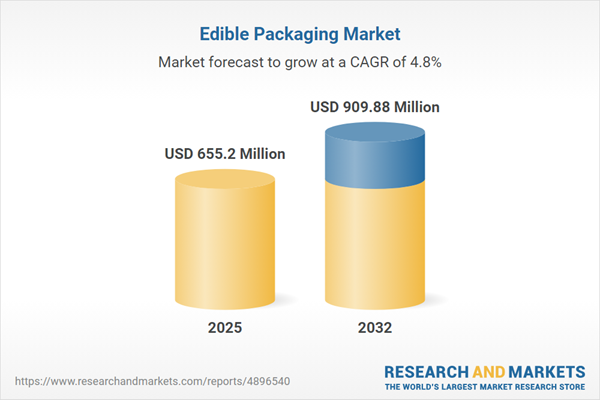Speak directly to the analyst to clarify any post sales queries you may have.
Edible packaging is emerging as a strategic solution for organizations focused on meeting sustainability directives and advancing responsible packaging across modern supply chains. This executive summary highlights actionable market intelligence for decision-makers assessing the regulatory, technological, and operational dynamics shaping this evolving packaging segment.
Market Snapshot: Edible Packaging Market Size and Growth
The global edible packaging market size has reached USD 625.72 million and is projected to attain USD 909.88 million by 2032, with a compound annual growth rate (CAGR) of 4.79%. Market expansion is propelled by rising adoption of advanced material standards and ongoing innovation to address compliance needs. Emerging material science solutions deliver effective, compliant packaging tailored to evolving supply chains. Enhanced edible coatings and biopolymer formulations enable longer shelf life and greater utility, while stakeholders drive advancements through demands for transparency and more robust accountability measures across the edible packaging sector.
Scope & Segmentation in the Edible Packaging Market
- Material Types: Composite-based, lipid-based, and polysaccharide options—including alginate, cellulose, starch, casein, gelatin, and soy protein—allow for customizable solutions aligned with specific operational needs and compliance requirements.
- Packaging Formats: Capsules, edible coatings, barrier films, stretch films, and flexible pouches offer flexible choices supporting waste reduction and reliable product protection in diverse applications.
- Applications: Solutions support food, bakery, beverage, dairy, meat alternatives, cosmetics, pharmaceuticals, and dietary supplements, each presenting unique regulatory and performance challenges.
- End Users: Food service providers, manufacturers of consumer goods, and retailers adopt edible packaging to advance their sustainability objectives and secure product integrity.
- Sources: Ingredient sourcing incorporates animal-based (casein, gelatin), plant-based (cellulose, corn, seaweed), and microbial (bacterial cellulose, algae) raw materials to match varying ethical, environmental, and regulatory frameworks.
- Technologies: Casting, extrusion, spraying, and 3D printing processes enable scalable, customizable packaging solutions featuring targeted barrier and functional properties.
- Regions: Geographic dynamics require region-specific strategies, as regulatory requirements and partnership opportunities differ across the Americas, Europe, Asia-Pacific, and Middle East and Africa markets.
- Leading Companies: Cargill, DuPont de Nemours, ADM, Monosol LLC, TIPA Corp., PT Evoware Jaya, Notpla Ltd., Loliware, Aquapak Polymers, and WikiFoods are key players influencing standards, innovation cycles, and competitive landscapes.
Key Takeaways for Senior Decision-Makers
- Strategic partnerships with suppliers and regulatory stakeholders accelerate progress on sustainability benchmarks while aligning with evolving customer and market expectations.
- Investing in new material technologies and flexible packaging formats supports market access, adaptability, and product line diversification within heavily regulated industries.
- Strong supplier engagement enhances agility and risk management, enabling faster adaptation to regulatory shifts and shifting end-user demands in global supply chains.
- Advanced monitoring and automation streamline quality assurance and facilitate efficient achievement of compliance targets throughout product lifecycles.
- Developing regionally tailored regulatory strategies enables smooth market entry and ongoing compliance, supporting local adaptation and business continuity.
- Prioritizing lifecycle management and ethical sourcing strengthens supply chain circularity, supports environmental objectives, and adds measurable value through reduced end-of-life impact.
Tariff Impact: Implications for Edible Packaging Supply Chains
Recent U.S. tariff adjustments are reshaping procurement strategies for polymers and bio-based raw materials in the edible packaging segment. Organizations are responding by evaluating local sourcing, diversifying agricultural inputs, and enhancing supply chain resilience, all while managing compliance and cost objectives. Continuous policy assessment and operational flexibility are now essential to maintain sourcing integrity and supply stability throughout the edible packaging value chain.
Methodology & Data Sources
This report draws from proprietary analytics, in-depth industry surveys, direct executive interviews, and peer-reviewed academic research, ensuring unbiased and actionable insights for edible packaging strategy and compliance.
Why This Report Matters: Strategic Value in the Edible Packaging Market
- Enables executive teams to anticipate supply chain changes, enhance planning, and foster compliance-driven innovation during a period of rapid industry transformation.
- Clarifies the influence of global regulations, local market distinctions, and technology adoption on future product positioning and sustainability efforts in the edible packaging sector.
- Assists organizations in aligning operational standards and sustainability priorities with evolving stakeholder and regulatory expectations.
Conclusion
This report equips senior leaders with the intelligence to refine edible packaging strategies, address regulatory evolution proactively, and reinforce sustainability foundations, securing a pathway for ongoing advantage in this strategic market.
Additional Product Information:
- Purchase of this report includes 1 year online access with quarterly updates.
- This report can be updated on request. Please contact our Customer Experience team using the Ask a Question widget on our website.
Table of Contents
3. Executive Summary
4. Market Overview
7. Cumulative Impact of Artificial Intelligence 2025
Companies Mentioned
The companies profiled in this Edible Packaging market report include:- Cargill, Incorporated
- DuPont de Nemours, Inc.
- Archer-Daniels-Midland Company
- Monosol LLC
- TIPA Corp.
- PT Evoware Jaya
- Notpla Ltd.
- Loliware Inc.
- Aquapak Polymers Ltd.
- WikiFoods Inc.
Table Information
| Report Attribute | Details |
|---|---|
| No. of Pages | 189 |
| Published | November 2025 |
| Forecast Period | 2025 - 2032 |
| Estimated Market Value ( USD | $ 655.2 Million |
| Forecasted Market Value ( USD | $ 909.88 Million |
| Compound Annual Growth Rate | 4.7% |
| Regions Covered | Global |
| No. of Companies Mentioned | 11 |









